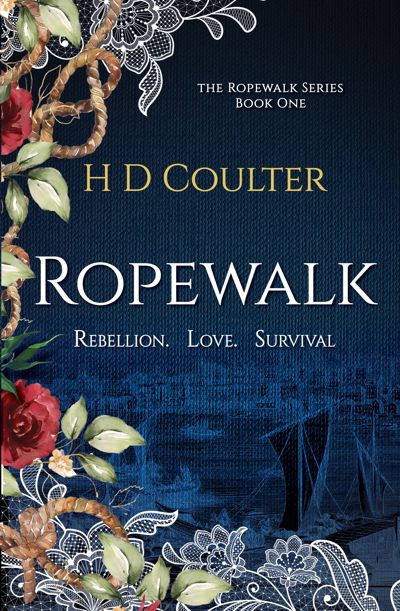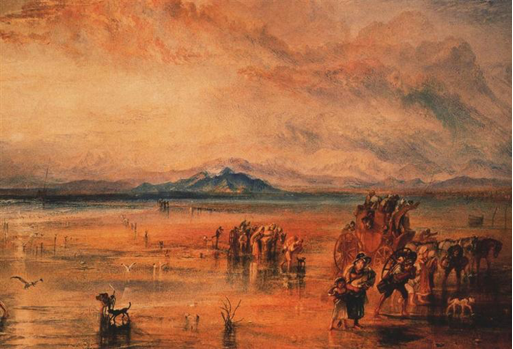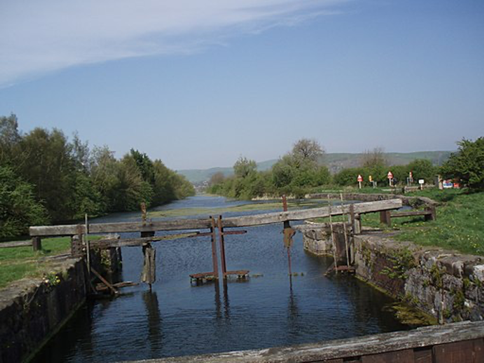
The North of England, 1831.
The working class are gathering. Rebellion is stirring, and the people are divided.
Beatrice Lightfoot, a young woman fighting her own personal rebellion, is looking for an opportunity to change her luck. When she gains the attention of the enigmatic Captain Hanley, he offers her a tantalising deal to attend the May Day dance. She accepts, unaware of the true price of her own free will.
Her subsequent entanglement with Joshua Mason, the son of a local merchant, draws all three into a destructive and dangerous relationship, which threatens to drag Beatrice, and all she knows into darkness.
Now, Beatrice must choose between rebellion, love and survival before all is lost, and the Northern uprising changes her world forever.
How the Ulverston became its own character.
I would like to thank Mercedes Rochelle for allowing to guest post on her Historical Fiction blog as I discuss how the historical town Ulverston became its own character in Ropewalk: Rebellion. Love. Survival.
“Ulverston, a small town crammed on to the side of an estuary, stood shielded by ancient fells. Whilst the growing high tide covered the last few remaining pieces of the decaying disused pier, a time before industrial advancement branded its mark on the area.” – Ropewalk
I set book 1, Ropewalk during a year of 1831, in Ulverston, a small town on the Leven Estuary, south to Lake District. I lived in the town whilst the idea of the novel flourished in my mind, with the landmarks and history fueling the plot. As a reader, I am drawn to a novel, especially a historic novel when the place in which they set it becomes an additional character. The town, city, place is as vivid to me as the protagonist of the story is. I would spend my weekends walking around the old harbour canal, discovering the Ropewalk and taking the hidden path along the coast to Conishead Priory. I have always loved history and finding hidden gems from the past in everyday modern life. To re-imagine the street, I am walking along back in the 1800s. So, I researched the town, the Ropewalk and the impact the canal had and so on. Which ended up leading me down the research rabbit hole.
That is one aspect I love about writing historical fiction is the research element, to look into one area and uncovering a game changing historical fact which shifts the story. When I researched the process of rope making, it drew me towards the canal which still dominates the area of Ulverston today. How it came about and the difference it made. Bit by bit, characters emerged in my mind. A young woman who lived in a small hamlet on the outskirts of Ulverston, who knew of hardship, family, money issues but who was also naïve to the social conflict happening around her. Stories of adventure and discovering unknown lands issuing from novels and town gossip from a local explorer, Sir John Barrow; created a yearning to change her fate. But when secrets and rebellion are exposed, it causes a dangerous chain of events.
Living in the area, I heard stories passed down through the generation, local historians sharing their knowledge and a treasure quest in discovering the historical plaques on the buildings. Ulverston itself is a character in Ropewalk with cobbles still lining the roads of the town centre. Georgian town houses and narrow alleyways create the maze you become lost in. The small, pokey bookshop crammed with local knowledge or the smell of the freshly brewed coffee coming from the teashop that had been there since the late 1800s. It wasn’t hard to imagine the characters I had formed walk the streets beside me. To study the old maps and emerge myself in their world. With researching Ropewalk, it wasn’t one area to look at, rather a blend of elements. Weaver cottage industry overtaken by the Industrial revolution and social conflict during the early reign of William IV with the Reform crisis, all taking place in this once quiet town.
The additional element Ulverston faced was the estuary. In 1831, there were minor roads out of the town, which took travelers days, weeks to get to Kendal and Lancaster or they choose to cross the sands. Which held its own dangers as people and carts avoided areas of quicksand and had to lead by a guide. Today, every couple of years, one man, whose family has been crossing the sand for generations, leaving markers to follow, takes a group out to experience the old path to Lancaster.

The issue that faces the Leven estuary is that it has a fast, shallow tide and mud flats instead of sand, shifting under foot. This meant before they built the canal, it had to be dredged regularly so that ships could sail into the small harbour, to bring trade, goods for sale, slate and iron ore from the fells. In the 1790s, a local merchant gathered together a group of business owners and built the canal. Between 1796 to 1850s, the canal changed Ulverston. It brought mills, shipyards, and gentry to the small town. Families travelled across the fells, leaving farms and abandoning homes at the chance of more money and a fresh beginning. But it also brought hardship and poverty to the town and increased the class division.
“To her, after every season that came and went, Ulverston grew bigger and louder thanks to the canal. If it had not come to be, would things be as they were now? Would the pier still have rotted away through lack of use? Would her Da still be a master at his craft? Would she have grown up in the workhouse instead of her family home?
And yet, Ulverston advanced before its time. Ships able to sail into the town centre doubled the amount of trade and business, bringing with it merchants, mills and the gentry, along with the promise of new jobs, and more workers than the small collection of buildings could house.” Chapter 1, Ropewalk.

In the early 1800s, along with industrial advancement and the reality of the new age, grew a spirit in the north amongst the working class. Whilst I was researching the fifty-year period, I discovered the Reformers and the plight for the right to vote. How these groups of people made it possible for us today to have our say in parliament. If they hadn’t rebelled against the government and the crown, so that everyday people could vote, how different would life be. As a person who has grown up in Cumbria and a proud Northerner, I saw the rebellious spirit of these people and the unacknowledged change they had created. During my research I first came across ‘Peterloo’ massacre in Manchester 1819 and the plight for workers. After the first rebellion, the government became fearful of the workers and created laws against groups in a rebellious manner and no more than 50 people gathering, the air was rife with the apprehension of another rebellion. But as the living conditions worsened and the only voice, they had to represent the working-class people, were the gentry based on the old system. They forced the workingmen to meet in secret. Pleading to the government for change and were met with false promises.
I imagined men from the mills and canal, who were once boys standing in St Peter’s field, were now men, risking their livelihoods or even their lives to meet in secret to discuss how they were going to bring about change. In reality, the Reformers became traitors to the crown and government as they organised strikes and riots when the bill kept failing in parliament. Forcing their hand for change until the Whig party took them seriously in 1832.
The Ropewalk series is a multi-book series. The first two-thirds of book 1, Ropewalk, take in Ulverston, from three different viewpoints. Bob Lightfoot, Master Rope maker and secret Reformer for the fight of the working class. Beatrice Lightfoot, swept up in breaking the confined bubble of the town and looking for a chance to change her fate. Joshua Mason, a young merchant coming home again from being in London and Liverpool, struggles to conform. I show the town from the rich to the poor, the false perception to the rebellious underground. Then, as the thread of the story knit together, the bigger picture reveals itself. Leading the reader on an adventure with the principal characters, not knowing where they might take them and a glimpse into the wider world.
Readers have fallen in love with the town, hope you do too.
This book is on promotion during the tour at 0.99 and signed copies of the paperbacks will be available on Hayley’s website – https://hdcoulter.com/
Amazon UK: https://www.amazon.co.uk/gp/product/B08MKZW4S5
Amazon US: https://www.amazon.com/gp/product/B08MKZW4S5
Universal Link to other bookshops: https://books2read.com/u/bxjlQd
You can Now PRE-ORDER Book 2, Saving Grace; Deception. Obsession. Redemption:
Amazon UK: https://www.amazon.co.uk/gp/product/B08YWBZRQY
Amazon US: https://www.amazon.com/gp/product/B08YWBZRQY
Universal Link to other bookshops: https://books2read.com/u/38QrBV
Meet H D Coulter
Hayley was born and raised in the lake district and across Cumbria. From a young age, Hayley loved learning about history, visiting castles and discovering local stories from the past. Hayley and her partner lived in Ulverston for three years and spent her weekends walking along the Ropewalk and down by the old harbour. She became inspired by the spirit of the area and stories that had taken place along the historic streets.
As a teacher, Hayley had loved the art of storytelling by studying drama and theatre. The power of the written word, how it can transport the reader to another world or even another time in history. But it wasn’t until living in Ulverston did she discover a story worth telling. From that point, the characters became alive and she fell in love with the story.
Connect with Hayley
Website: https://hdcoulter.com/
Twitter: https://twitter.com/coulter_hd
Instagram: https://www.instagram.com/hd.coulter/?hl=en
Facebook: https://www.facebook.com/hdcoulter
Thank you for hosting today’s blog tour stop!